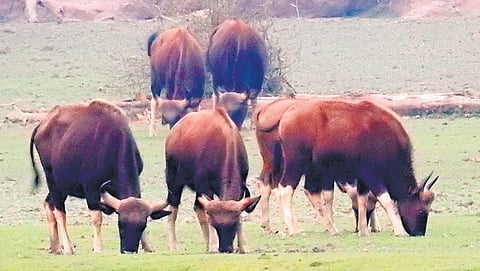

ADILABAD: Gaur, also known as the Indian Bison (scientific name: Bos gaurus), is the largest bovine species globally. This mammal is native to Southeast Asia, with its presence particularly prominent in the southern and Himalayan regions of the country. Its population has faced significant threats, leading to its classification as ‘vulnerable’ on the IUCN (International Union for Conservation of Nature) Red List since 1986. However, in the Kawal tiger reserve of Mancherial district, the number of gaurs has increased, as compared to the Amrabad or Srisailam tiger reserve.
According to Nirmal DFO K Ramakishan, the availability of vast stretches of land covered in grass could have contributed to the increase in the gaur population.
Venkat Anagandhula, a wildlife researcher at the Hyderabad Tiger Conservation Society, explains that conservation efforts are crucial to address these threats and ensure the survival of gaur population. This includes implementing measures to protect habitats, curbing poaching, raising awareness about the ecological importance of gaurs, and promoting coexistence between humans and gaurs to mitigate conflicts.
The gaur population faces threats due to habitat loss, poaching, and human-wildlife conflict. Conservation efforts are essential to safeguard this species and ensure the continued ecological benefits they provide to their habitats.